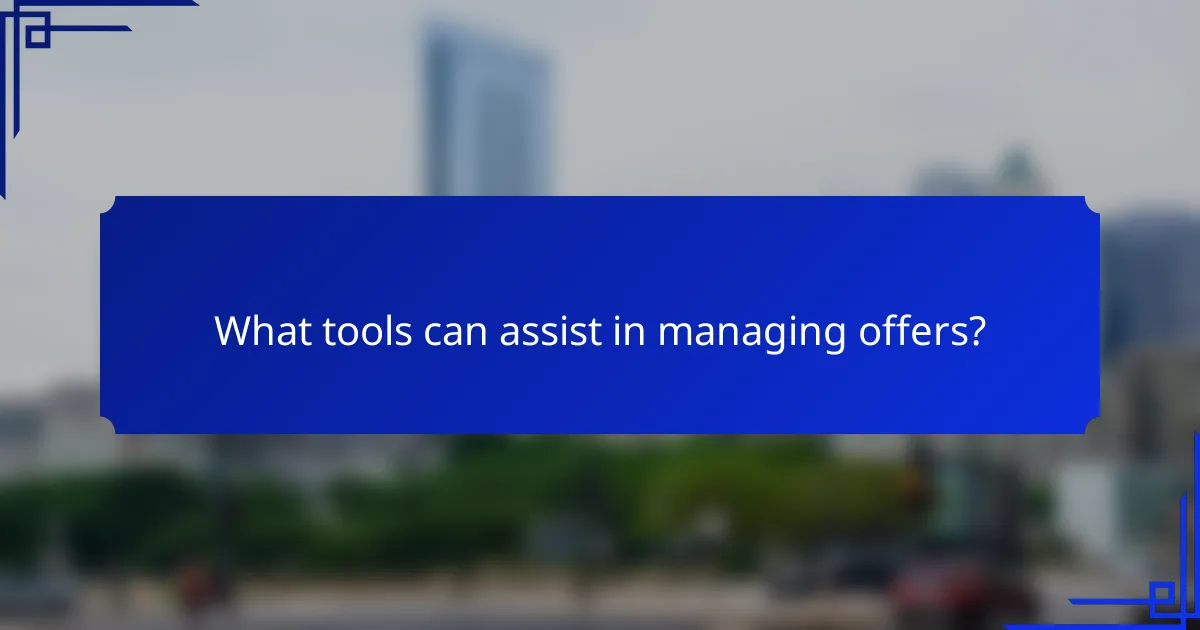Handling multiple offers in real estate requires a strategic approach to effectively evaluate each proposal. By focusing on key factors such as financial terms, contingencies, and buyer motivations, you can make informed decisions that align with your goals. Employing effective negotiation strategies, including transparency and tactical communication, will help you navigate offers and maximize your outcomes while maintaining professional relationships.

How to handle multiple offers in real estate?
Handling multiple offers in real estate requires a strategic approach to evaluate each proposal effectively. Focus on key factors such as financial terms, contingencies, and buyer motivations to make an informed decision.
Evaluate financial terms
Start by comparing the financial aspects of each offer, including the purchase price, earnest money deposit, and financing type. Look for offers that are not only competitive but also align with your financial goals.
Consider the net proceeds after closing costs, which can vary significantly based on the buyer’s financing method. For example, cash offers may provide quicker access to funds, while financed offers might involve additional contingencies.
Consider contingencies
Contingencies can significantly impact the likelihood of a successful sale. Common contingencies include home inspections, financing, and appraisal conditions. Evaluate how these contingencies might affect the closing process.
Less restrictive offers, such as those with fewer contingencies, may be more appealing. However, ensure that you are comfortable with the risks associated with accepting an offer that lacks thorough protections.
Assess buyer motivations
Understanding buyer motivations can provide insight into the strength of each offer. Some buyers may be motivated by urgency, such as relocating for a job, while others may be more flexible.
Engaging with buyers or their agents can reveal their level of commitment and willingness to negotiate. Offers from motivated buyers might warrant more consideration, especially if they align with your timeline.
Analyze closing timelines
Closing timelines can vary widely among offers and can influence your decision. Some buyers may be ready to close quickly, while others might need more time due to financing or personal circumstances.
Consider how each timeline fits with your plans. If you need to sell quickly, offers with shorter closing periods may be more attractive, even if the price is slightly lower.
Review offer strengths
Each offer will have its unique strengths and weaknesses. Look beyond the price to assess other factors such as the buyer’s financial stability, their ability to waive contingencies, and their proposed closing date.
Creating a checklist of strengths for each offer can help you visualize which proposals stand out. This method allows you to make a more balanced decision based on a comprehensive view of each offer’s merits.

What negotiation strategies work best?
Effective negotiation strategies for handling multiple offers include understanding your value, being transparent, and employing tactical communication. These approaches help you navigate offers and maximize your outcomes while maintaining professional relationships.
Counter-offer techniques
Counter-offering is a powerful technique that allows you to negotiate better terms based on your value and market research. Start by evaluating the initial offers and identifying areas where you can request improvements, such as salary, benefits, or work conditions.
When crafting a counter-offer, be specific about what you want and why. For instance, if one offer is higher in salary but lower in benefits, you might propose a salary that reflects the best of both offers. This shows that you are informed and serious about your worth.
Leveraging buyer competition
Leveraging competition among buyers can significantly enhance your negotiation position. When you have multiple offers, you can communicate this to potential employers, which may prompt them to improve their offers to secure your acceptance.
Be careful to maintain professionalism when discussing competing offers. You can mention that you are considering other opportunities without disclosing specific details. This approach can encourage employers to present their best terms upfront.
Creating urgency
Creating a sense of urgency can motivate employers to act quickly and present their best offers. You can achieve this by setting deadlines for your decision or highlighting your interest in other opportunities that require a prompt response.
However, use this tactic judiciously. If you push too hard, it may backfire and lead to a negative impression. Instead, frame it positively by expressing excitement about the role while indicating that you are in demand.

How to make a decision among multiple offers?
To make a decision among multiple offers, evaluate each option based on your priorities and long-term goals. Consider factors such as price, terms, and conditions to determine which offer aligns best with your needs.
Prioritize key criteria
Identifying your key criteria is essential when evaluating multiple offers. Common factors to consider include price, location, property condition, and financing options. Rank these criteria based on what matters most to you, which will help streamline your decision-making process.
For instance, if proximity to work is a top priority, you may favor offers in that area even if they are slightly higher in price. Alternatively, if budget constraints are critical, prioritize offers that meet your financial limits.
Consult with a real estate agent
A real estate agent can provide valuable insights when navigating multiple offers. They have experience in assessing market trends and can help you understand the implications of each offer. Their expertise can guide you in negotiating better terms or identifying potential red flags.
When discussing offers with your agent, be clear about your priorities and concerns. This collaboration can lead to a more informed decision, ensuring you choose the best option available in your market.
Utilize decision matrices
Creating a decision matrix is a practical way to compare multiple offers objectively. List your offers and key criteria, then score each offer based on how well it meets your needs. This visual representation can clarify which offer stands out.
For example, you might assign scores from 1 to 5 for each criterion and then total the scores for each offer. This method allows you to quantify your preferences and make a more informed choice based on the data collected.

What are the common pitfalls in managing multiple offers?
Managing multiple offers can lead to several pitfalls that may hinder effective decision-making. Key challenges include ignoring buyer qualifications, overlooking emotional factors, and failing to communicate effectively with all parties involved.
Ignoring buyer qualifications
One major pitfall is neglecting to assess the qualifications of each buyer. Understanding the financial stability and readiness of potential buyers is crucial, as it helps to filter out offers that may not be viable. For instance, a buyer with pre-approved financing is generally more reliable than one who is still seeking funding.
To avoid this mistake, create a checklist of buyer qualifications, including financial backing, contingencies, and timelines. This will help you prioritize offers that are more likely to close successfully.
Overlooking emotional factors
Another common mistake is disregarding the emotional aspects of the selling process. Buyers often have personal motivations that influence their offers, such as a desire to move closer to family or to find a home that resonates with their lifestyle. Recognizing these emotional drivers can provide valuable insights into which offers may be more genuine or committed.
To navigate this effectively, engage in conversations with potential buyers to understand their motivations. This can help you gauge the seriousness of their offers and may lead to better negotiation outcomes.
Failing to communicate effectively
Effective communication is essential when managing multiple offers, yet many sellers fall short in this area. Lack of clear communication can lead to misunderstandings, missed opportunities, and even the loss of potential buyers. Keeping all parties informed about the status of their offers fosters transparency and trust.
Establish a regular communication schedule with buyers, updating them on the process and any developments. This not only keeps them engaged but also enhances your reputation as a seller who values professionalism.

How does local market impact offer handling?
The local market significantly influences how offers are handled, affecting both the number of opportunities and the negotiation dynamics. In a competitive market, buyers may face multiple offers, while in a slower market, offers may be less frequent and require different strategies.
Understanding market trends in Los Angeles
Los Angeles is known for its dynamic real estate market, characterized by fluctuating demand and varying property values. Trends can shift based on factors such as economic conditions, population growth, and interest rates, which can all impact how offers are made and received.
For example, during a seller’s market, properties may receive multiple offers above the asking price, necessitating a strategic approach to bidding. Conversely, in a buyer’s market, there may be more room for negotiation, and buyers can often secure properties below the asking price.
Comparing offers in competitive markets
In competitive markets, comparing offers requires a keen understanding of not just the price but also the terms and conditions attached to each offer. Key factors to consider include contingencies, closing timelines, and the buyer’s financial qualifications.
When evaluating multiple offers, create a comparison chart to visualize the strengths and weaknesses of each. This can help clarify which offer aligns best with your goals. For instance, an offer with a higher price but numerous contingencies may be less attractive than a slightly lower offer with fewer conditions.

What tools can assist in managing offers?
Managing multiple offers can be streamlined with the right tools, which help organize and evaluate options effectively. Utilizing technology can enhance your decision-making process and ensure you don’t overlook critical details.
Using CRM software
Customer Relationship Management (CRM) software is a powerful tool for managing offers, especially in sales and recruitment contexts. It allows you to track interactions, compare offers, and maintain a clear overview of each opportunity.
When using CRM software, consider features like customizable pipelines, automated reminders, and reporting tools. These features help you stay organized and make informed decisions based on data rather than intuition alone.
Popular CRM options include Salesforce, HubSpot, and Zoho, each offering various pricing tiers and functionalities. Choose one that fits your specific needs and budget, ensuring it can scale as your requirements grow.
